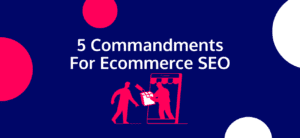“Crosslinking” is a term used in two ways when talking about websites. Although both processes are designed to improve a website’s Google rankings, they do so in very different ways.
Within this blog, we are going to focus on the internal linking – cross linking method as opposed to the crosslinking of two websites. However, we have included definitions of both below.
Confused about crosslinking? Then read on for definitions, benefits and and our easy how-to guide.
Table of Contents

Define crosslinking
Crosslinking two websites definition
Crosslinking for SEO can refer to the process of linking between two separate domains. Like with backlinks, Google rewards websites with crosslinks from relevant and reputable sites that add value to the content being linked to.
Unlike backlinks, however, which typically direct their link value in one direction, crosslinking connects two websites, building reciprocal links that have big potential benefits for SEO. For those looking to reap these rewards of this technique, however, websites need to closely adhere to the guidelines set out by Google.
Crosslinking and internal linking definition
Crosslinking can also be used interchangeably with the term “internal linking”. This is defined as the process of linking one webpage to another within the same domain.
As with backlinks, crosslinking or internal linking is an important part of any good SEO linking strategy. It’s crosslinking of this variety that will be the focus of our blog.
There are several different types of crosslinks. In addition to links on your homepage and menu, you can also add links within your content. These are called contextual links. They involve linking relevant topics in one piece of content to another piece of related content within the same domain, typically using anchor texts ( text on a page with the clickable hyperlink attached to it).
Why is crosslinking (internal linking) important?
In terms of SEO, backlinks have huge benefits for a website. Unfortunately, even with brilliant linkable assets receiving backlinks is mostly out of your control.
What you can do, however, is control the crosslinks/internal links present on your website.
Crosslinking internally : the 5 main benefits
– Crosslinking helps Google understand and rank your website
It’s important to remember that Google bots are designed to recreate a user’s thinking process. These bots, which crawl and index URLs, are responsible for finding, analysing and deciding where websites appear in search results.
This means that by improving user experience through crosslinking, this will, in turn, help improve your ranking with Google. For, as Google itself says, the better it understands your site, “the better it can match it to people who are looking for your content.”
2. Crosslinking improves user experience through anchor texts
By choosing user-friendly and descriptive anchor texts you will improve the useability of your website. Using these anchor texts to link to related content that will interest your readers, will also help users navigate your content and website better.
If the content you provide through internal linking is relevant and provides real value to your audience, they are more likely to use the anchor texts to click through and read further articles. As a result, this means visitors to your site will stay longer, which in turn will reduce bounce rate and increase your site’s conversion rate. Acting as a good user signal to google to improve your rankings.
3. Crosslinking helps you boost
Crosslinking between your posts and page means you can signal to search engines the hierarchy of your website’s content. This allows you to give the most important pages more value than other pages, which are less valuable.
- Crosslinking helps spread the link value or juice
If a website (especially a reputable one) references yours with a DoFollow link, it acts as a vote of confidence from them. It tells the search engine that your site is valuable and informative. This is what we mean by “link juice” or “page rank”.
Internal linking helps you pass this link juice on from one page to another within the same domain. This helps to boost the visibility and authority of other pages of your site.
wANT AN EXPERT LEVEL CONTENT SILO AND INTERNAL LINKING FOR YOUR SITE? iF SO, GET IN TOUH WITH US!
Cross-linking for SEO: how to do it
For those new to SEO the concept of crosslinking might seem a little daunting. Websites recommending complex linking strategies and content “silos” are likely to make you feel even more overwhelmed.
But finding a flowing way to connect the content on your website (which is essentially what crosslinking is) doesn’t need to be complicated. Instead, we suggest focussing on user experience, quality content, and naturally linking pages. By doing so, you’ll appeal to both users and Google.
Start with keyword research
Creating keyword rich content which throws up natural opportunities to link won’t happen on its own – you need a strategy.
This research will form the basis of your content strategy, and from which you can create pillar pages and content clusters – all of which are great for SEO.
Create lots of quality content
In the world of digital marketing and SEO, quality content is still King. In order to link internally through contextual links, you need to have lots of great content on your website.
Of course, when creating within a niche, opportunities to link between different webpages and content sources that are relevant to your pillar pages, will occur naturally.
Keep your anchor text natural
When crosslinking it’s important to use a user-first approach. This means focussing on improving the value and accessibility of a webpage for the user, instead of trying to appeal to Google’s algorithm.
So, when it comes to choosing anchor text and linking opportunities, instead of using keywords (which might be tempting), it’s best to use words and phrases that are natural for the reader and that fit within the given context.
Create a structure (Your site silo)
As already mentioned, crosslinking helps create a hierarchy of importance within your website. The more internal crosslinks a webpage gets, the more important Google will assume it is.
This means that the most important pillar pages should always be the ones with the most amount of authority being passed through to them. This does not necessarily mean “have the most links” being directed towards them, but instead potentially having pages which might already have a lot of links being directed towards sub topics, then pointing to them. How you do this is all dependent on the site silo structure you take, but below is an example of a ‘priority silo’ technique.
Choose an appropriate amount of links
When it comes to the amount of links to use, Matt Cutts of Google suggests a reasonable amount of around 100, but this is totally dependent on the size of the website you have. Remember, that’s 100 including all the links on the page, such as those in the header, footer and sidebar.
Given the above – and although there is no perfect number – the addition of 3 or 4 crosslinks within the body of text is a pretty safe bet.
Again, it’s important to think about the user when adding these crosslinks.
Ask yourself: are these links adding value for the user? Are they improving navigation around my content and website? When it comes to choosing where and when to link, these questions should help inform your decision.
Link deep within your website
In terms of crosslink for SEO, the most important links are those embedded deep within the structure of a website.
However, as your website evolves and grows, some pages may become weakly connected to the most important pages. It’s important to return to these pages and re-stablish these links so that Google is reminded these are valuable pages and to rank them.
Use “dofollow” links
Labelling links as either dofollow backlinks or nofollow tells Google identify whether to pass on link juice (dofollow) to a website, or not (nofollow).
When it comes to crosslinking strategies, there is some debate amongst experts on the use of dofollow and nofollow. However, while nofollow links have their value, dofollow links are arguably the best way to build out the internal link architecture of your website.
This is because the link juice needs to flow freely within these internal pages, rather than get stopped by a nofollow. So, when it comes to cross linking, keep things moving by using dofollow. It also allows crawlers to read all the content on your site efficiently, thus maximising your crawl budget.
Crosslinking for SEO: things to avoid
Over-optimising your anchor text
Keyword stuffing/overusing your keyword in the anchor text is viewed by google as an attempt to game the system and can punish websites for doing so. Although not as likely with internal links, still tread carefully. Matt Digerty has stated that from tests he has carried out in the past, having 100% varied keyword anchor texts get the best results in terms of rankings.
Too few crosslinks/internal links
If you’ve read the above then you should know that without enough crosslinks your users – and your Google ranking – will suffer. Make sure to hit the “sweet spot” of a reasonable amount, without over-optimising.
No crosslinks
Those pages without any links at all are called orphan pages. The search engine assumes that the pages are being purposefully hidden from Google and are part of a black hat SEO scheme. Google can punish whole websites for orphan pages, making them very detrimental from an SEO standpoint.
Linking too much to your homepage
Instead of simply directing links to the homepage (the homepage should have lots of links already), it’s best to try and strengthen internal pages to boost over SEO of your website.
When looking to build a linking strategy for your website and business, it can help to speak to an expert. Why not book in a free discovery call with Digital Rainmaker to find out how we can help?





